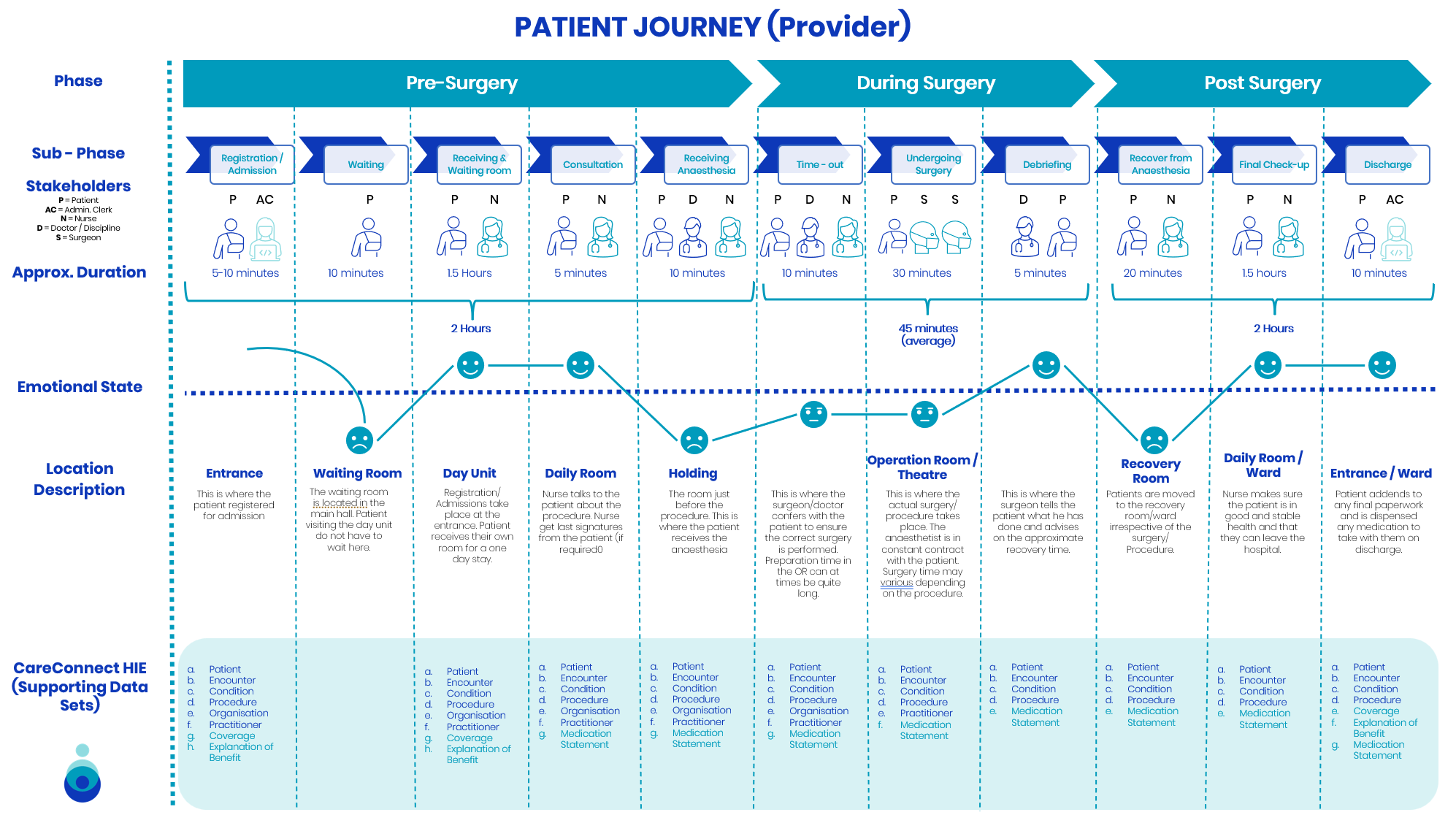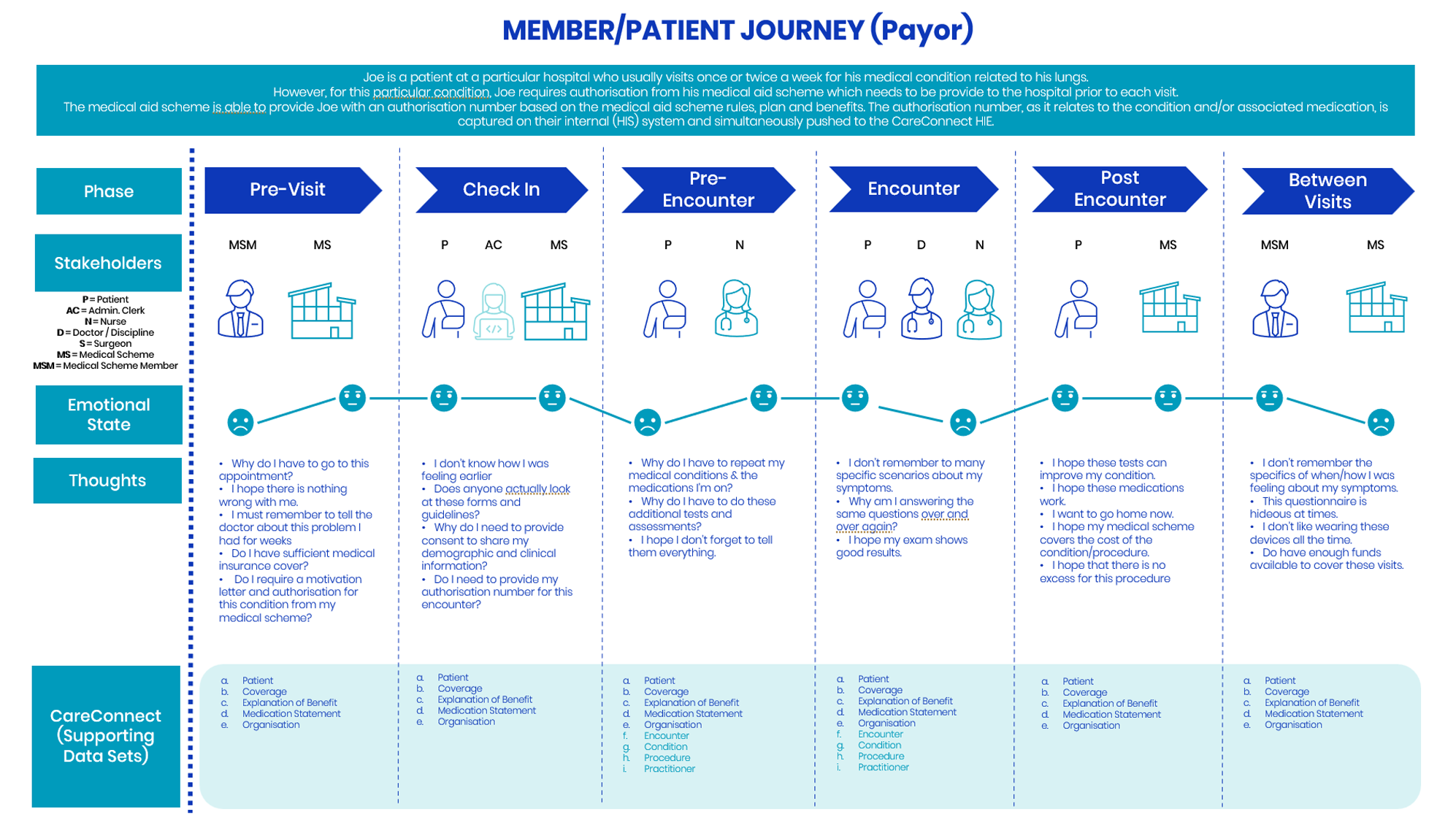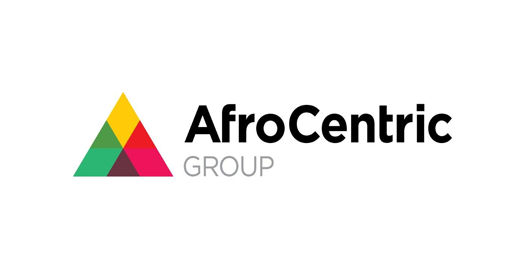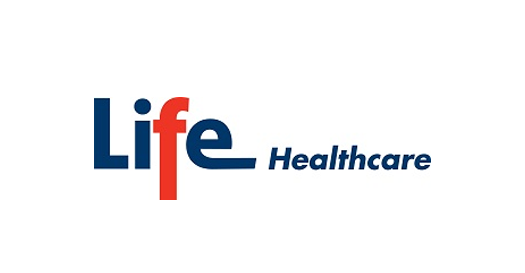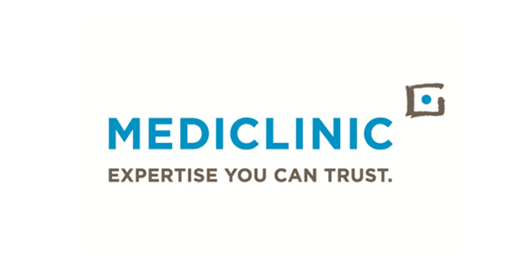
Patient Journey
At the core of any HIE is the availability of comprehensive and good quality data. The value of an HIE grows exponentially as more data is added, thereby benefiting all its participants. The use cases presented here are only the beginning of the HIE journey for South Africa’s health sector. As more participants join and share their data, additional use cases will emerge, contributing to enhanced quality of care, improved outcomes, coordination of care, performance-based reimbursements, standardisation, and much more.
Current Use Cases
Elective Admission
This use case is relevant in the instance where a patient needs to be admitted for a particular procedure which requires authorisation from the patient’s insurer. During the admission process, the hospital admission clerk will need verify the patient’s insurance details. This is a achieved as follows:
- Hospital Admission Clerk captures the patient information and registration date into their registration system and requests insurance verification from the CareConnect HIE.
- CareConnect HIE provides the patients insurance information such as authorised cover, membership details, waiting period etc.
- Hospital Admissions Clerk is then able to admit the patient and provide them with efficient access to care.
"Breaking the Glass”
This use case is relevant in the instance where an unresponsive patient is able to receive emergency medical treatment for a “sensitive” condition to which they have not consented to be shared. The treating doctor, in consultation with other clinicians, decide to “Break the Glass” and request whether the CareConnect HIE has any clinical information on the patient which potentially could be related to their suspected medical condition.
Participants will be responsible for consulting their clinical governing bodies to determine their respective organisation’s stance on overriding consent.
Consent Revoked
This use cases is relevant in the instance where a patient no longer wishes to share their information and approaches a participant. The participant loads the necessary consent end-date on their internal system and in turn sends CareConnect HIE a revoke consent message.
Hospital Emergency Visit
for Injury
EXAMPLE USE CASE: This use case is relevant in the instance where a patient requires emergency hospital care. As the hospital in integrated with CareConnect HIE, both the admissions clerk and Emergency Doctor is able to view information on the patient. However, based on the role assigned to the admission clerk, the clerk is only able to view the patient’s demographic details but is alerted to the fact that there is also clinical information available for the patient which is relayed to the Emergency Doctor who in turn will be able to access the CareConnect HIE (based on their assigned role) in order to view the patients clinical information such as prior hospital visits, diagnosis, medications, episodes of care etc.).
Non-responsive Patient Admitted to the Emergency Department
EXAMPLE USE CASE: This use case is relevant in the instance where an unresponsive patient is taken to an Emergency Department and needs to be admitted. Fortunately, the emergency responders are able to find patients ID document allowing the Hospital Admissions Clerk to look up the patients details in their internal system who in turns sends a message to the CareConnect HIE. CareConnect HIE provides patient demographic information such as emergency contact information etc. and alerts the admissions clerk to the fact that there is also clinical information available for this particular patient which is relayed to the triage nurse. The triage nurse is then able to request the patient’s clinical information (e.g., previous hospitalisation etc.) using their internal system to request the patient’s clinical information from the CareConnect HIE thereby allowing the triage nurse to advise the emergency staff of the patient’s previous hospitalisations and to instruct the patients admission.
Change of Personal,
Non-Medical Information
EXAMPLE USE CASE: This use case is relevant in the instance where a patient arrives for a check-up at a participating health facility. An authorised CareConnect user is able to look-up the patients’ most-up-to date details which can be validated with the patient. In the event that the patients elect to change any of their information, the administrative clerk is then able to update their details in real-time to the CareConnect HIE thereby allowing for the most recent details to be available/visible without the patient having to go to all participating FM’s to update their details.
Current Radiology Use Cases
Hospital Admission (after hours)
EXAMPLE USE CASE: On the weekend, Mrs. Moloi arrives at the Netcare Wilgeheuwel hospital complaining of severe abdominal pain which is protruding into her pelvis. Mrs. Moloi provides the administration clerk with her ID number and contact number. Based on the information provided by Mrs. Moloi, the administration clerk accesses the Netcare HIS and can pull up Mrs. Moloi’s personal and medical insurance details which is then verified/validated with Mrs. Moloi. Before signing the necessary admission documents, the administration clerk asks Mrs. Moloi whether her personal and clinical information can be shared with the CareConnect HIE. Mrs. Moloi agrees (consents) to this, and all the necessary documents are sighed. While waiting to see the attending doctor, Mrs. Moloi’s details are retrieved and placed in the file ready for the attending doctor to review. The attending doctor logs into the system and can view Mrs. Moloi’s historical and present clinical information such as prior hospital visits, diagnosis, medications, conditions, radiology reports and results. Based on the clinical information available for Mrs. Moloi, the attending doctor can make an informed diagnosis which is captured on their system and passed through to the CareConnect HIE in real time and merged with information which already exists on the HIE for Mrs. Moloi.
Hospital Emergency Visit for Injury
EXAMPLE USE CASE: A patient involved in a severe motor vehicle accident arrives at the Mediclinic Morningside hospital. The ambulance staff provide the admissions clerk with information they were able to gather on the patient. Using the information provided, the admissions clerk accesses their internal hospital system and can locate the patients personal and clinical information. A file is created for the patient which is then forwarded to the Emergency doctor treating triage cases. The emergency doctor access their system and can view all the patients present and past diagnosis’s, conditions, medications, radiology tests and results. Based on the patient’s clinical information, the emergency doctor is then able to prescribe the necessary X-ray to performed for the patient. The X-ray department conducts the necessary test, and the results are sent back to the emergency doctor. The diagnosis together with the X-ray results are captured and uploaded in their system which then sent through to the CareConnect in real time and merged with the patients details which are already on the HIE.
Authorised and Claimed Radiology Tests
EXAMPLE USE CASE: A patient arrives at a specialist upon referral from her treading provider. During the consultation the specialist suggests that the patient goes for an MRI scan to aid him in providing the patient with a proper diagnosis. After the consultation, the patient realised that based on her medical aid scheme rules, she is required to first obtain authorisation from her scheme before she can go ahead with the MRI scan. The patient duly contacts her medical aid and requests that this MRI scan be authorised and provides her scheme with the details (ICD-10 or LOINC code) of the MRI that needs to be . Based on the patients plan benefits and the information provided, the scheme (or scheme administrator) advises the patient that she is eligible to go for the MRI scan and provides patient with the authorisation number. At the same time, the scheme/scheme administrator captures the authorisation number (including authorisation start and end dates) linked to this patient record on their system which is simultaneously transmitted in real time to the CareConnect HIE. The patient arrives at the radiology practice ready to undergo the MRI scan. Once completed, the MRI scan and results are uploaded to the CareConnect HIE. At the follow-up consultation, the Specialist logs into their system and is able to view the patients MRI results which discussed with the patient. Using the scan results, the specialist, in consultation with the patient, is able to develop a treatment plan for the patient.
Consent Revoked Use Case
EXAMPLE USE CASE: Equipped with a referral letter from his specialist, a private patient arrives at a radiology practice requesting that a specific X-ray be performed for the patient. The administration clerk requests that the patient complete the necessary documentation and based on the referral letter provides the patient with a quotation for the procedure. Before accepting the signing the relevant documentation, the patient is advised that the information he provided will be captured on their internal system and as the practice is a participant of the CareConnect HIE, his information will also be shared with the HIE. The patient agrees to this and provides the necessary consent by reading and accepting the terms and conditions before signing the radiology request form. The administration clerk captures the patients’ details, including his consent, into their internal system. The patient undergoes the requested information and the test results together with the patients’ details is transmitted to both the referring specialist and the CareConnect HIE.
Upon reflection, the patient realises that the test results could potentially contain sensitive information about his condition which he would not like to have visible on the CareConnect HIE. The patient contacts the radiology practices and requests that all his information (including radiology tests and results) not be shared with the HIE. The radiology practice loads the necessary consent end-date on their internal (PAC) system which in turn sends a revoke consent message to the HIE. CareConnect removes and purges all the patient’s information.

